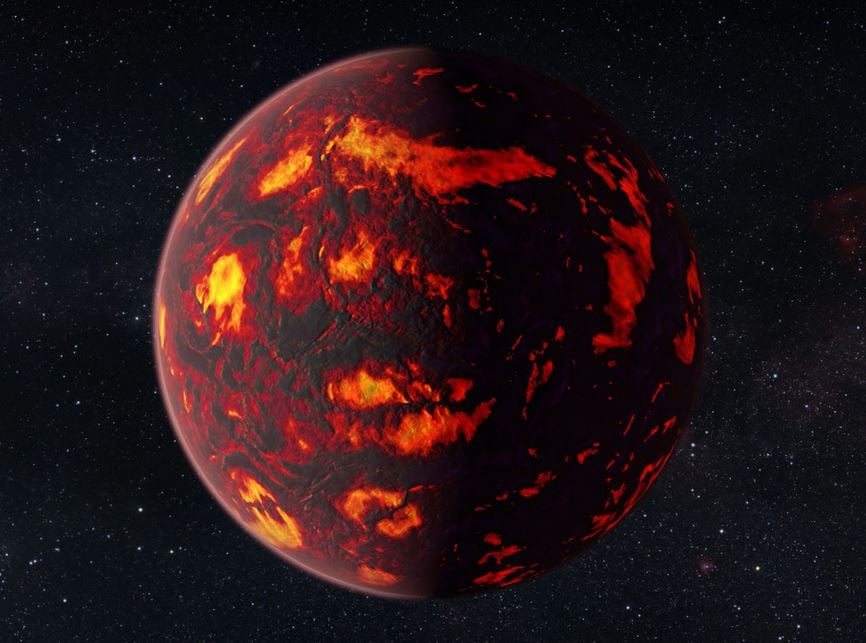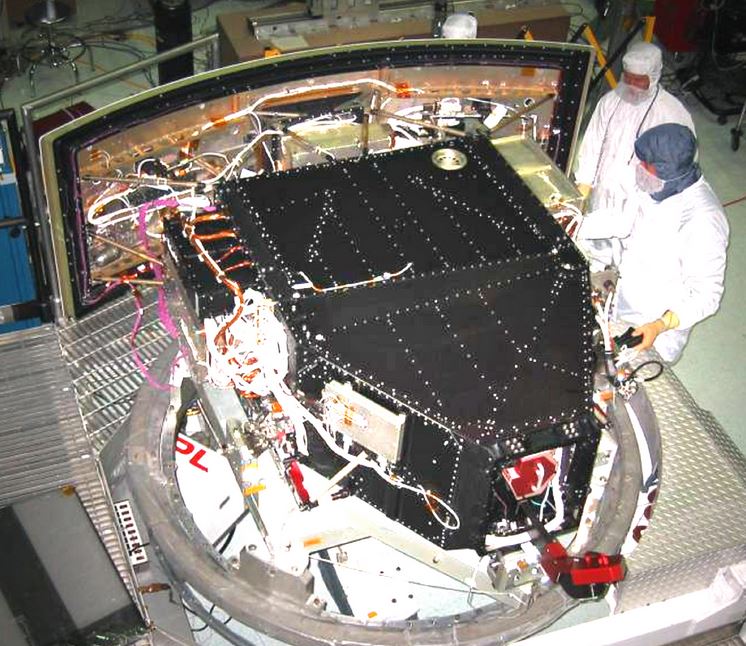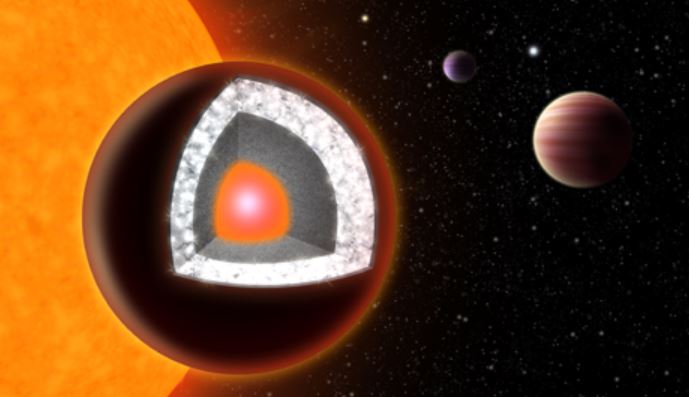A distant planet, about 40 light-years from Earth, has an atmosphere mainly of helium and hydrogen, say scientists from University College London (UCL) and other European centres, but no water vapour has been detected on the ‘super-Earth’.
A super-Earth is an exoplanet (planet outside our Solar System) that has a greater mass than Earth, but much less than that of the ice giants like Neptune and Uranus. They are believed to be the most common type of planet in our galaxy.
This is the first successful detection of gases within the atmosphere of a super-Earth, the researchers say, who wrote about their study and findings in the peer-reviewed Astrophysical Journal (citation below).
 This is the first super-Earth outside our solar system with an atmosphere we have been able to detect. It is doubtful there would be any life as we know it on this planet – it is extremely hot and appears to have no water. (Image: ucl.ac.uk)
This is the first super-Earth outside our solar system with an atmosphere we have been able to detect. It is doubtful there would be any life as we know it on this planet – it is extremely hot and appears to have no water. (Image: ucl.ac.uk)
55 Cancri e probably a carbon-rich planet
This exotic planet, called 55 Cancri e, has more than eight times Earth’s mass. It had previously been nicknamed the diamond planet because models based on its radius and mass have led some scientists to speculate that it is carbon-rich inside.
The researchers say they used new processing techniques on data from the NASA/ESA Hubble Space Telescope to examine the atmosphere of 55 Cancri ‘in unprecedented detail’.
Angelos Tsiaras, a doctoral student at UCL, who developed the analysis technique along with colleagues Dr Ingo Waldmann and Marco Rocchetto from UCL Physics & Astronomy, said regarding their findings:
“This is a very exciting result because it’s the first time that we have been able to find the spectral fingerprints that show the gases present in the atmosphere of a super-Earth.”
“Our analysis of 55 Cancri e’s atmosphere suggests that the planet has managed to cling on to a significant amount of hydrogen and helium from the nebula from which it formed.”
 Engineers next to the Wide Field Camera 3 instrument in its enclosure in the Clean Room at Goddard Space Flight Center before it was added to the Hubble Space Telescope, which is in low-Earth orbit. In this study, scientists used data gathered from this camera. (Image: NASA)
Engineers next to the Wide Field Camera 3 instrument in its enclosure in the Clean Room at Goddard Space Flight Center before it was added to the Hubble Space Telescope, which is in low-Earth orbit. In this study, scientists used data gathered from this camera. (Image: NASA)
Hubble’s WFC3 (Wide Field Camera 3) has already been used to search for atmosphere on two super-Earths, but nothing was found in them.
A super-short year and ultra-hot surface
One year for 55 Cancri e is really short – just 18 hours – while temperatures on its surface are estimated to reach approximately 2000 °C. The exoplanet is located in a planetary system that orbits 55 Cancri, a star on the Cancer constellation about forty light-years from here. N.B. ’55 Cancri’ is the star while ’55 Cancri e’ is the super-Earth that orbits it.
Thanks to 55 Cancri being such a bright star, the researchers were able to use new analysis techniques to extract data regarding its orbiting planet.
Observations were made by scanning WFC3 rapidly across the star to create several spectra.
By combining these observations and processing through computer analytic ‘pipeline’ software, Tsiaras and colleagues were able to retrieve the spectral fingerprints of 55 Cancri e embedded in the star’s light.
First insight into a super-Earth’s atmosphere
Giovanna Tinetti, Professor of Astrophysics at UCL, who focuses on galactic planetary science – trying to understand the chemical composition of exoplanets in our Galaxy – said:
“This result gives a first insight into the atmosphere of a super-Earth. We now have clues as to what the planet is currently like, how it might have formed and evolved, and this has important implications for 55 Cancri e and other super-Earths.”
 An artist’s impression of 55 Cancri e. According to Yale University: “[55 Cancri e is] an extremely hot planet with a surface of mostly graphite surrounding a thick layer of diamond, below which is a layer of silicon-based minerals and a molten iron core at the center.” (Image: yale.edu. Credit: Haven Giguere)
An artist’s impression of 55 Cancri e. According to Yale University: “[55 Cancri e is] an extremely hot planet with a surface of mostly graphite surrounding a thick layer of diamond, below which is a layer of silicon-based minerals and a molten iron core at the center.” (Image: yale.edu. Credit: Haven Giguere)
Interestingly, the data also hinted at a signature for hydrogen cyanide (HCN), generally a marker for carbon-rich atmospheres.
Co-author, Dr. Olivia Venot, who works at the Institute of Astronomy (Instituut voor Sterrenkunde), KU Leuven, Belgium, who developed the atmospheric chemical model off 55 Cancri e that supported the analysis of the observations, said:
“Such an amount of hydrogen cyanide would indicate an atmosphere with a very high ratio of carbon to oxygen.”
Co-author Jonathan Tennyson, Professor of Physics at UCL’s Department of Physics and Astronomy, said:
“If the presence of hydrogen cyanide and other molecules is confirmed in a few years’ time by the next generation of infrared telescopes, it would support the theory that this planet is indeed carbon rich and a very exotic place.”
“Although, hydrogen cyanide or prussic acid is highly poisonous, so it is perhaps not a planet I would like to live on!”
UCL’s research was funded by the ERC projects ExoLights and ExoMol, and the Science and Technology Facilities Council.
The Citation is for arXiv, a repository of electronic preprints (article not yet printed in The Astrophysical Journal): “Detection of an atmosphere around the super-Earth 55 Cancri e,” A. Tsiaras, M. Rocchetto, I. P. Waldmann, O. Venot, R. Varley, G. Morello, M. Damiano, G. Tinetti, E. J. Barton, S. N. Yurchenko & J. Tennyson. The Astrophysical Journal. 7 February, 2016. arXiv:1511.08901 [astro-ph.EP].
Video – 55 Cancri e, an unusual expoplanet
This NASA video about 55 Cancri e was issued in 2012, a long time before this latest study took place. However, it contains useful information about the super-Earth.

